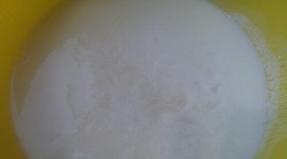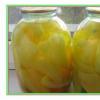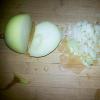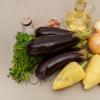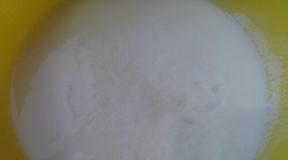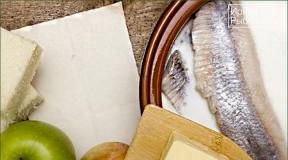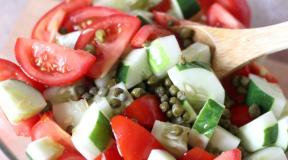Why does curdled milk not sour? Doesn't sour, doesn't whip
A few memories: in the USSR, milk was sold on tap for 28 kopecks per liter, they carried it in cans and they noticed that cream quickly accumulated on the surface of the milk. They could be scooped off with a spoon and eaten, or added to coffee. And when the milk was boiled (this was necessary, because the bottled milk was not sterile), a film always formed on the surface. If the milk was yesterday's milk, when boiled it curdled - it turned into white flakes and clots floating in the water. At this point it could be thrown into a colander lined with gauze. It was tied in a knot and hung so that the remaining water would drain from the clot. The result was the most delicate homemade cottage cheese. They also often made yogurt from milk at home, and whipped butter from cream. Why are such tricks impossible with the milk that is sold today in stores and markets?
Milky Way
To understand the features of modern milk, you need to imagine what happens to it on the way from the cow to the store. Firstly, today milk is necessarily subjected to heat treatment - pasteurized (heated to 60-80 C and kept at this temperature for half an hour to an hour) or sterilized (heated over 100 C).
But the main difference between modern milk and classic milk is related to its structure. Under a microscope, milk from a cow looks like an emulsion of fat in water: in each milliliter of milk there are more than 2 billion large fat globules, each ranging in size from 1 to 10 microns, floating. If such milk is left alone, it will begin to make cream on its own. The balls will float to the surface, since fat is lighter than water, and stick together. The resulting fatty film is the cream. You just need to remove it, and that’s it - the cream is ready. Today, milk is necessarily homogenized: it is thoroughly mixed so that all the fat globules are broken almost into dust - their size becomes no more than 1 micron. As a result, such milk does not separate and does not form cream. These dust balls do not float up and remain in the water column. This type of milk is called homogenized milk. If you try to beat it into butter, it won't work.
Why doesn't it sour?
Modern milk is practically sterile: lactic acid bacteria, which cause milk to sour, have been killed. Thanks to this, it can be stored in bags and bottles for months without spoiling. If you open such a package, it will most likely become rotten or rancid (rather than sour!). In the first case, destruction (rotting) of the protein will occur in it under the influence of bacteria from the air. In the second - the oxidation of milk fats. This process is called rancidity, since the substances formed from fats have exactly this aroma and taste.
Soviet milk was not sterile. Although it was also pasteurized, even after that the lactic acid bacteria were not killed. Over time, they came to life and fermented the milk, turning milk sugar into lactic acid - eventually forming curdled milk. And if a spoonful of kefir was added to the souring milk, homemade kefir was obtained. Now this method will not work: and here the reason is in kefir. The fact is that today dry starter cultures are used to produce kefir and other fermented milk products, and they differ from the Soviet ones. New starter cultures are usually intended for one-time use, and when added again they are no longer active, especially towards the end of the kefir’s shelf life.
No time for cottage cheese
You can still make cottage cheese from modern milk. How? It is better to take not ordinary milk, but so-called “selected milk”. It is sold in plastic bottles, marked “solid”. This suggests that milk has a natural fat content, not normalized to 3.2% or 1%, but what it was immediately “from under the cow” - usually from 3.4 to 6%. And this is not sterile milk, it is only pasteurized. Therefore, it is much better suited for making cottage cheese and fermented milk products at home.
Sourdough can be made from natural sour cream. Dissolve 2 tablespoons in half a glass of lukewarm milk. When pouring this starter into a liter of lukewarm milk (temperature approximately 36-4 C), you need to stir constantly so that it dissolves well. Cover the resulting mixture and place in a warm place. You can use a yogurt maker. Curdling can last 6-12 hours. The curd curd is considered ready if it does not collapse when you try to push it away from the wall of the dish with the tip of a knife. The whey must be carefully drained so as not to damage the curd. Then use a long knife to cut the curd to its entire depth (so that the knife reaches the bottom of the dish). Ideally, the cut lines will form a grid about 1.5-2 centimeters in size on the surface of the clot. Line a colander with 3-4 layers of gauze and drain the clot onto it. Tie the ends of the gauze and hang the curd to drain. There is another secret technique that improves the quality of cottage cheese and speeds up the process. Immediately after introducing the starter into the milk, rennet enzymes can be added. They are sold in specialized stores online. Instead, you can use Abomin tablets (these are the same enzymes). For a liter of milk, you need to dissolve 2-4 tablets in half a glass of lukewarm water.
30/11/2012
Today, for some reason, it is believed that any products with a long shelf life are not natural, not healthy, and sometimes downright harmful. It is believed that manufacturers add something to them that is carefully hidden from us, and only thanks to brave journalists does the entire criminal plot occasionally come to the surface.
WITH Today, for some reason, it is believed that any products with a long shelf life are not natural, not healthy, and sometimes downright harmful. It is believed that manufacturers add something to them that is carefully hidden from us, and only thanks to brave journalists does the entire criminal plot occasionally come to the surface.
Today, almost everyone knows that shelf-stable milk (the same milk that can be stored in a closed package for six months or more) is a “chemical” hazardous to health. What did the manufacturer put in the bag instead of milk, what antibiotics and how will they affect our health? I myself have more than once seen young mothers in the store passing by packages of such milk with an arrogant and even disgusted grimace. They apparently know the secret. And you? Let's look point by point.
"Antibiotics are added to milk"
They can only get there from cows, which are sometimes treated with antibiotics for various infections. And sometimes they even give it as a preventive measure. Nobody adds antibiotics to milk. Although, of course, it’s difficult to give a guarantee about “nobody”. But if you buy a carton of milk from a large manufacturer, then you can be sure that nothing has been added to it, and any incoming raw materials are analyzed at the entrance. This is called “quality control”, and every large enterprise has it. Milk bought from your grandmother at the market should raise much more questions.
"There are antibiotics in milk"
Antibiotics can be found in almost any modern milk. The reason for this is not greedy manufacturers, but the success of analytical chemistry, which can detect the smallest quantities of any substance contained in a product. This same analytical chemistry, by the way, regularly detects mercury, cadmium and lead in milk. And if you try hard enough, you can find uranium and gold if you want.
The question that consumers should ask themselves is how much of these substances there is, and whether their content does not exceed the established safe doses. Usually do not exceed. Any decent manufacturer monitors the quality of its products, this saves a lot of effort, time and money.
“Milk doesn’t sour for a long time, which means it’s not natural.”
An extremely common misconception. I wonder if those who think so understand the viciousness of this formulation from a logical point of view? Let me explain. In construction, the statement in question is completely identical to the following verbal construction: “Oranges are grown in Florida, which means they are not blue.” Did anyone find this expression logical?
Let me explain again. It does not sour - this means that for some reason (more on them later) bacteria do not develop in the milk. Natural means that it is made by nature, obtained from a cow. These concepts are not related. Milk always comes from a cow. To prevent it from souring, special processing methods are used. When you roll up a jar of mushrooms at home and they don’t turn sour for several years, at what point do they stop being natural?
“Milk doesn’t sour for a long time, which means there’s something wrong with it.”
Strictly speaking, there is something wrong with milk when it turns sour. At this point it ceases to be milk and becomes a fermented milk product. It turns sour due to the activity of microorganisms (bacteria and fungi), mainly lactic acid. They got their name in connection with the ability to “feed” on milk sugar - lactose, producing lactic acid, which in turn denatures the protein and gives fermented milk products a sour taste.
There is simply no long-term storage of these and other bacteria in milk - they were destroyed by high-temperature treatment. That's why it doesn't turn sour. Not because antibiotics were added to it, but because all germs were removed from it. With the help of the oldest and most reliable “antibiotic” on the planet - high temperature.
By the way, pathogenic bacteria that can cause various kinds of diseases were also removed from this milk. In this sense, shelf-stable milk is much healthier than fresh village milk, in which you can find a whole zoo with not the most plausible intentions.
“Milk doesn’t sour for a long time even in an open carton, which means there’s something wrong with it.”
As I hope became clear from the previous paragraph, bacteria are needed to sour milk. Lots of bacteria. Any bacteria flying around the kitchen won't do. We need a specific lactic acid bacterium.
The environment around us today is relatively sterile compared to a dairy farm. Opening a carton of sterile milk in a clean environment and pouring the milk into a glass through a small hole will prevent you from introducing a lot of bacteria into the package. And those units that are still able to fly in will fall on the surface of the milk, and on the surface they will multiply, gradually conquering new milk territories for themselves. It’s good if there is a warm kitchen on the table, but most likely they will have to do this in the refrigerator, in very uncomfortable conditions for them. Didn’t you know that bacteria are extremely inactive at low temperatures? This is exactly what refrigerators were invented for.
Another thing is milk from a cow, or even pasteurized milk, which contains a certain amount of living bacteria “not killed” by pasteurization. In such a product, all microorganisms are uniformly mixed throughout the entire volume.
By the way, if you add starter into milk with a long shelf life, mix it and put it in a warm place, then everything will ferment perfectly. Tested many times. You can check it yourself and make sure. This is a very simple experiment, which for some reason many supporters of the “milk with antibiotics” version do not even think about. Maybe they are afraid to be convinced of their own delusions?
“Milk that has been stored for a long time goes bad, but doesn’t turn sour, which means there’s something wrong with it.”
This really happens, but it has nothing to do with the quality of the milk. The process of deterioration of this product is controlled by microorganisms, those that “flew” from the air. There is something “wrong” with them.
Milk contains not only lactose sugar, but also protein and fat. Accordingly, microbes in milk can live not only lactic acid microbes that feed on lactose. It contains so-called “proteolytic” ones, which feed on protein (rare article), and “lipolytic” ones, which prefer fat. Some proteolytic bacteria are literally “putrefactive.” During protein processing, they release a number of unpleasant-tasting, bitter, and even toxic substances. The activity of “lipolytic” microorganisms leads to the formation of a rancid taste.
As in any other community of living organisms, between the microbes in souring milk there is a fierce competitive struggle for survival, in which all means are good. Usually it is won by lactic acid ones. The lactic acid they produce simply reliably suppresses the development of competitors. Another thing is a just opened sterile package. Ubiquitous proteolytic bacteria have every chance of getting to the favorable dairy soil faster than their competitors and spoiling the product before anyone else. As a result, the milk “goes bad,” but does not “sour.” But the manufacturers have nothing to do with it.
By the way, regular pasteurized milk can “go rotten” already in the package. Pasteurization, while generally effectively dealing with delicate lactic acid microorganisms, leaves alive many “putrefactive” spores, which, when awakened, begin to spoil the product. Sterilization and ultra-pasteurization are practically free of such drawbacks.
“Milk that has been stored for a long time in the refrigerator goes rancid and goes rotten, which means there is something wrong with it.”
Cold, of course, slows down the development of many microorganisms. But it would be naive to believe that evolution will bypass cool places and not populate them with organisms that would thrive in these conditions.
The so-called “psychrotrophic” microorganisms, capable of reproducing at low and even subzero temperatures, are permanent inhabitants of our refrigerators. They will definitely fly into an open carton of milk. Habitual lactic acid microorganisms, even if they are present in milk, do not feel very good in the climatic conditions of a refrigerated shelf, much like polar explorers at a station in Antarctica. For psychrotrophs, these conditions are a resort and a home; they are the penguins that polar explorers envy when they look out the window. So they win in the end. As a result, the milk “spoils” and becomes rancid. But the manufacturers are not to blame for anything here either.
For those who still don’t believe, I’ll ask a rhetorical question. Why do the antibiotics that manufacturers supposedly add kill lactic acid bacteria, but do not affect all the others, allowing the milk to “go rotten”?
Tricky question
For centuries, for millennia, humanity has been trying to make long-lasting food for itself. We invented the processes of salting, smoking, drying, fermenting - everything that spoils the appearance and nutritional value of products, often making the product more harmful. We did this with only one goal - to extend the life of our food. Save it for as long as possible.
We have achieved our goal. Today we have technologies that extend the life of milk without changing the composition and without harming the body. When and why did it become something bad? ?
Here's the problem: I bought milk, put it in the refrigerator, forgot, remembered a week later, decided to fry the pancakes, since they were sour, I took it out - and the milk was not sour, but bitter, smelly and kind of black, eww!
Or I bought milk for yogurt, so that it’s thick, tender, sour, like in childhood. I put the bottle in a warm place, nothing happens for a day, nothing happens for two days, and on the third day, instead of curdled milk, there is a bitter, stinking slurry, and it even turns black. Ewww again!
“What do they add to this milk, I suppose there’s no milk in it at all! Previously/in childhood/in the village/under the Union (choose the one you need) this didn’t happen!” - an indignant cry from an upset customer is heard.
Actually, it was. And before, and in the village, and during the Union, and always. Let's figure it out.
Who lives in milk?
The normal microflora of milk is extremely diverse. Includes lactic acid bacteria, butyric acid bacteria, yeast, and much more. All transformations of milk depend on who from this zoo will reproduce and suppress the development of the rest. Under normal conditions, lactic acid bacteria are the strongest, they gradually destroy all (well, almost) other microorganisms, and the usual yogurt is obtained. But as often in life, it happens that it is not the strongest who wins, but the most persistent...
Why does milk go rancid in the refrigerator?
In a regular refrigerator it is about 5C. At this temperature, the lactic acid bacteria needed for curdled milk do not die, but they do not develop either, they simply sleep. But butyric acid and putrefactive bacteria, for example, feel good. In a few days, without meeting the resistance of sleeping lactic acids, they completely take over the world, that is, milk, and here it is - phew!
Why does milk go rancid when warm?
Lactic acid bacteria, the “curd milk makers,” develop at a temperature of 10-40C, preferably 30-35C. But under one condition: if they are present in milk in sufficient quantity. Pasteurization of milk, as we know, is heating to a temperature of 64-74C (or sharp cooling to 1-2C). With such heating, almost all pathogenic flora dies, and the milk becomes safe. But lactic acid bacteria don’t like this temperature either! But persistent yeast and butyric acid bacteria are completely calm about any pasteurization. And so, again, in the absence of their worst enemies, lactic acid streptococci, the milk is freely captured by the flora, turning it into a bitter, stinking fuuuuuuu!
What's a yogurt lover to do?
1) do not put milk in the refrigerator;
2) if the milk is pasteurized, add lactic acid bacteria to it (a spoonful of self-fermented sour cream, for example, or rye crust)
3) take into account that many farmers cold pasteurize milk, that is, they cool it very much after milking so that it does not become sour (as we now know, they kill lactic acid bacteria). Formally, such milk is not considered pasteurized, but without sour cream it will not sour well.
Igor Nikolaev
Reading time: 3 minutes
A A
To ferment milk, many housewives resort to ready-made starter culture. A small part of it could have been saved from a previous product or purchased in a store. And sometimes you have to wait for the milk to ferment naturally. It is left at room temperature, specially placed in heat, but nothing happens. The fermentation process does not start. At worst, it becomes rancid. Why doesn't homemade cow's milk turn sour?
Cool or heat?
To observe the process of souring of cow's milk, take two jars. One contains sterilized milk, the other contains fresh milk. After a certain time, both of them turn sour.
In the first container, the liquid will ferment for a long time. The process will begin gradually, it will take more than a week to reach yogurt. Raw milk, in the absence of pathologies in the animal and proper feeding, will also last for several days in the refrigerator.
In some cases it suddenly becomes sour, while in others the process never begins. As a result, it can be frozen or heated, but it is not possible to obtain the desired product.
Cow diet
Often the answer to the question of why homemade cow's milk does not sour is overfeeding the animal with protein foods.
Proportions in feed are not observed:
- Sahara;
- protein.
As a result, metabolism is disrupted. This is especially noticeable when the cow is given acidic plants, bagasse, kale, and so on. When animals eat mint, the clotting of milk by rennet slows down.
Ketone bodies accumulate in milk, which are clearly not beneficial for people. The use of such a product even leads to poisoning. It takes a long time to sour and becomes unpleasant to the taste. Often, instead of sour milk, you get rotten milk. This is due to the fact that the process of rotting proteins and destruction of fats occurs before souring.
The volume of cake and alfalfa hay supplied should be reduced, and meadow hay should be added instead. Adding baking soda to the cow's feed has a positive effect on the fermentation of milk.
Reasons for lack of fermentation
If the cattle diet is being followed and there is no information about disease, it is sometimes necessary to reconsider where and when milk is purchased. Some tricks that are used to increase the shelf life of a homemade product slow down its souring:
- adding soda, antibiotics, ammonia, peroxide, preservatives and other foreign substances to fresh product, to female cattle feed;
- diluting milk with water. It will take a very long time to wait for such a liquid to become acidic;
- the milk is too fatty. A thick layer of cream prevents oxygen from reaching the drink. Fermentation does not occur;
- There is very little time left before calving. At this time, the composition and properties of milk also change;
- The milk was placed in the refrigerator instead of being kept warm. Lactic acid bacteria multiply very slowly in cool weather;
- To make the product, an old, no longer active starter is used.
When buying homemade milk, you need to take all these points into account and try to purchase a proven product.

Hello, friends!
If you decide to pamper your family with truly delicious, healthy dairy products, you need to learn how to choose homemade milk.I want to tell you how to distinguish milk from a sick cow from a healthy one just by smell and appearance. I gained all this knowledge from my own many years of experience with this amazing living product.
- Flavors of homemade milk
First of all, pay attention to the appearance of the hostess and the counter. Keeping a cow is a troublesome and not very clean business. If the housewife is not neat, then what kind of cow is she? So, you have chosen a hostess. It's time to choose milk.
How to evaluate homemade milk by cream
It is difficult to identify defects in fresh (morning) milk by smell. Choose a jar in which the cream has already settled. Smell the milk with the top of it settled. In the top you will hear almost all the shortcomings. If the milk has a taste or smell, the top will immediately give it all away. If you shake the settled cream, you may not notice the unpleasant smell.To understand the smell:
1. Open the can on the counter and immediately smell the milk. Inhale deeply through your nose, hold your breath and exhale slowly through your mouth.
2. After exhaling, rub your tongue across the roof of your mouth. Taste the smell. Wait a few minutes. If there is an unpleasant taste in your mouth, refuse to purchase. Foreign odors in homemade milk in most cases indicate an animal illness.
Note!Milk from a healthy, cleanly washed cow has no foreign smell, taste or aftertaste.
Freshness of the product in appearance
You can tell how fresh the milk is by looking at the settled cream. Is it really an evening milk yield, as the hostess says, or has the jar been in the refrigerator for a couple of days already? To find out how “evening” the milk is, look carefully at the surface of the cream. It should be liquid, homogeneous, without points, clots, or compactions.The surface color of the cream should be the same as the rest of the cream. Rock the jar very carefully. If the top seems to be compacted, then the milk is more than 12 hours old. The denser the upper surface of the cream, the older the milk. Evening milk cream is practically no different in liquid from ordinary homemade milk.
When buying a product from a new owner for the first time, ask to pour the milk into your jar without shaking the top. Of course, you will lose a little fat, but if the cow was milked dirty, you will see a dark stripe on the glass in the residue flowing from the can.
Determining a defect by the taste of cream
Taste defects in milk are most easily detected in cream. In order to understand the most subtle shades, you need to swallow such an amount that when you press your tongue on the palate, your entire tongue becomes covered with cream and flows into your throat. Now we need a little time. About five minutes. If after this time no unpleasant aftertaste appears in your mouth, you have found good milk.Cow diseases caused by inflammatory processes in the udder or metabolic disorders will certainly affect the taste and smell of milk. An unpleasant taste also appears in raw materials obtained from animals during the treatment period. High-quality milk has a pleasant, slightly sweet taste and without any aftertaste.
Flavors of homemade milk
Cows have the best milk in winter. Fat content and density are high. This is due to the fact that in winter the cow consumes less succulent feed and more concentrated feed. If an animal receives a complete diet, then in winter it produces less milk than in summer, but of higher quality. It produces a higher yield of cheeses, increases fat content and density.Off-flavors in homemade milk may be caused by natural conditions of the cow or may be evidence of disease.
For natural reasons, milk may change taste:
1. During the period of deep pregnancy. Deficiencies may appear during deep pregnancy. It may acquire a bitter, salty, or “old milk” taste. At the same time, the product’s content of dry substances, vitamins and fats even exceeds the usual values. The curd after souring is dense, there is little whey. When fresh, such homemade milk is practically indistinguishable from regular milk, but the longer it sits, the more pronounced the deficiency becomes. If you buy such milk, it must be consumed or prepared immediately, without allowing an inch to settle. When my cows are heavily pregnant I cook.
2. Spring milk. Milk changes its taste when cows go out to pasture in the spring. A sudden change in diet affects the taste and smell of milk. It becomes more pronounced, brighter, but still pleasant.
3. Eating large quantities of certain herbs: wormwood, tansy, buttercups, hare cabbage, wild garlic and onions.
The listed natural causes of the appearance of foreign tastes are purely individual for each animal. I had cows that gave excellent quality milk even during deep pregnancy.
There is an opinion that if homemade milk smells like a cow, then it was not washed well. This happens, of course. But from my own experience I can say that the appearance of such a taste most often indicates an animal’s illness.
Note!Milk from sick cows always acquires foreign odors and leaves an unpleasant aftertaste. The more intense the unpleasant taste, the more severe the stage of the disease.
The smell and taste are also influenced by the population of milk with various colonies of bacteria. A product even from a healthy animal can acquire foreign odors if sanitary standards have not been met (for more information about the defects of milk from healthy cows, see the article “Why homemade milk smells unpleasant”).
How do you know if the taste in milk is a natural characteristic of the animal, or if the cow is sick?
Quality of fermented milk by appearance
If you bought milk and want to make sure it came from a healthy cow, put the jar in the refrigerator for 12 hours to allow the top to settle. Then place it in a dark, warm (19-22 degrees) place away from heat sources, and leave it alone until it sours. Do not cover the jar with a lid. Milk must breathe. Cover with a napkin or a piece of gauze.It is by sourness that we will finally determine whether the cow is sick:
1. Mastitis (inflammation of the mammary gland).
2. Ketosis (metabolic disorder).
The conditions for souring milk are of great importance. When exposed to ultraviolet light, vitamins in milk are destroyed very quickly. The taste of milk whey that has turned sour in the sun takes on a dusty taste and goes rancid.
With rapid souring under the influence of high temperature (25 degrees and above), the milk sours quickly and turns out to be too sour, the curd does not have time to ripen.
Important! Place the can of milk away from heat sources in a dark place not exposed to sunlight, or cover it with a dark cloth.
The souring time depends on the environment and the initial temperature of the milk. If it is very cold it will take longer. Milk at room temperature will turn sour in a couple of days.
Why does milk take a long time to sour?
I am often asked the question: “If milk does not turn sour for a long time, is this a sign of illness or evidence that something was added to the milk?” I will answer in as much detail as possible.On average, fresh milk at a temperature of 23 degrees sours for 8-10 hours. If the milk is cold, it needs time to warm up. If the cow was cleanly milked and the milk was poured into sterile jars, the souring time may increase.
Milk that is taken out of the refrigerator and left to sour in a cool room can sour for up to seven days or even more! At the same time, cottage cheese from such a “ripened” curd (provided that the milk is from a healthy cow) will be more tasty and sweeter.
If sanitary standards and storage temperature conditions are not observed during milking and storage of milk, the milk can sour quickly, because souring is the proliferation of fermented milk colonies of bacteria, and the more different colonies that enter the product, the faster souring occurs.
At unsatisfactory storage temperatures, bacteria multiply faster, and therefore the souring process occurs in a shorter time.
At the same time, a product to which various chemical compounds have been added that inhibit or completely stop the proliferation of bacteria may not be fermented at all. The product becomes sour and unpleasant in taste, the smell is musty, rancid, and unpleasant.
Conclusion! It doesn’t really matter how long homemade milk takes to sour. The souring time depends on many factors and is not a sign of health or illness of the cow, or the addition of chemical elements to the raw material. The main indicator of quality is the clot that you get in the end.
Curd in milk from healthy cows
What should be the curd and top of sour whole milk from a healthy cow?The top should be a uniform yellow color and practically not separate from the main clot. If there are air bubbles in it, this is normal. Inspect the top crust of the sour top. If you see islands of flowering that are almost the same color as the rest, this is normal.
Mold of a pinkish, grayish or too yellow color usually appears when there are colonies of various bacteria and fungi in the milk, which enter the milk due to animal diseases and violations of sanitary standards during the milking process.
Carefully remove the crust from the top. Using clean gauze, remove the remaining top film from the walls of the jar. Take a sniff. The smell will say a lot. It should be pleasant, slightly sour, without a rancid aftertaste.
Milk from healthy cows has a homogeneous curd, with few or no air bubbles. There is almost no serum. In sour milk made from high-quality milk from healthy cows, it makes up no more than one-fourth of the total volume.The serum is liquid like water. There are no signs of mucus or stringiness. The smell is sour, pleasant.
A clot in milk from sick cows
Lift the jar and inspect the bottom. A cow suffering from hemarogic mastitis (inflammation of the mammary gland with the release of pus and blood) has a reddish sediment at the bottom of the jar. Also a sign of the disease will be small dark grains, clots, flakes that differ in color (they are clearly visible at the bottom of the jar).
Evidence of an animal's disease will be if the clot jumped up, floated above the serum, or even crawled out of the jar and shriveled. The serum has separated a lot and smells unpleasant (sometimes even like vomit). The top of this milk is filled with a large number of air bubbles (carbonated). Cottage cheese from such milk is crumbly, hard, with little weight yield and an unpleasant aftertaste (often bitter).If the whey is viscous, thick, “snotty”, the taste of the top is unpleasant, fetid, bitter - the cow is sick with ketosis (metabolic disease). Most often it develops due to an unbalanced diet.
We usually check cows for mastitis at every milking. For this purpose, the veterinary pharmacy sells the product “Mastisan” or “Masited”. You can buy it freely and test the milk at home with a 100% guarantee.
To do this, take a sterile white plate and mix 2 cubes of milk (not cream) and 1 cube of product. Chat for about a minute. If the mixture remains liquid, the cow is healthy, if it thickens, the cow is sick. The thicker the mixture, the stronger the inflammation.
Important! A healthy cow can also test positive for “mastied” if she calved no more than 10-15 (sometimes up to 20) days ago.
If it is not possible to buy the product, then there is a method for determining the disease called the “settling test.”
You need to take a test tube or a tall thin glass dish, pour fresh milk and leave it in the refrigerator for 24 hours. Carefully inspect the bottom. If the milk at the bottom has acquired a different shade (reddish, grayish) or clots, crumbs, or some other sediment appears, you bought milk from a sick cow.
I may have tired you with such a detailed story, but we want to prepare a product that is beneficial and not harmful.
Conclusion! If you have found a clean housewife and healthy homemade milk, you have taken a big step towards the abundance and variety of healthy natural dairy cuisine.
Dear friends. At our next meeting, I will tell you how to prepare delicious cottage cheese.
I sincerely hope that my knowledge will be useful and help make your life healthy and well-fed. See you.
Copyright © Natalya Ivashchenko.01 November 2015

